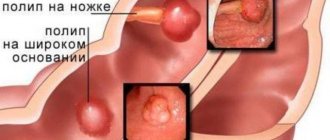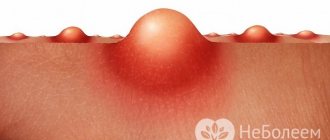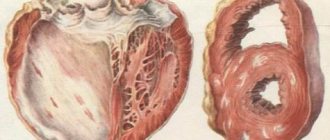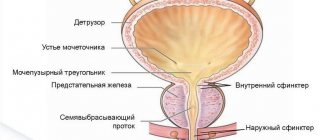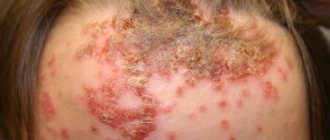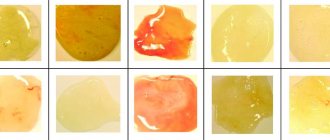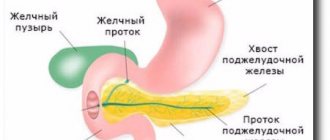The process of formation of polyps in the uterus begins with a disruption in the functioning of the ovaries, when excessive amounts of estrogen begin to be released in the blood. With normal ovarian function, estrogen dominates in a woman’s body only in the first half of the menstrual cycle (two weeks), and with ovarian dysfunction, this hormone begins to be produced continuously, which leads to the growth of the endometrium. As a result of disruption of the exfoliation of areas of the endometrium over several menstrual cycles and their growth into the walls of the uterus, seals appear, into which connective tissue fibers and blood vessels penetrate. These are polyps.
According to medical observations, in recent decades, the formation of polyps in the uterus has become detected much more often even in women who have not given birth, in pre- and postmenopausal women (40-50 years old) and teenage girls from 11-12 years old, which has changed the opinion about the development of polyposis uterus only in women who have given birth.
General information
Gastric polyps are benign tumors of epithelial origin of various origins that protrude into the lumen of the stomach.
ICD-10 code: K31.7 Polyp of the stomach and duodenum. In recent years, there has been a widespread increase in the number of patients with diseases of the digestive system, in the structure of which precancerous diseases of the stomach occupy a significant place (about 12%). Gastric polyps develop most often in patients aged 40-50 years, more often in men. Polyps are located exclusively on the inner surface of the stomach, have a stroma (connective tissue base) and are covered with a hypertrophied/atrophic mucous membrane, in which there is a proliferation of the integumentary epithelium and its glands (papillomatous tissue itself). The structure of the polyp consists of a body, a stalk and a base (Fig. below).
The base of the polyp is located in the mucous membrane.
The muscular and serous membranes are not involved in the pathological process. The stalk of the polyp can vary in thickness/length, and its structure is similar to the structure of the mucous/submucous membranes of the stomach. Less often, the polyp pulls back the fold of the mucous membrane with its weight and then the formation of a false pedicle is noted. The stroma of the polyp is rich in blood/lymphatic vessels, which are often dilated and located superficially just under the epithelial cover. Polyp tissue is often involved in a chronic inflammatory process of the gastric mucosa; less often, there is no inflammatory process in the polyp tissue. Ulceration and necrosis may also be present on the surface of polyps .
Polyps vary widely in both shape, consistency, and size. There are round, oval, finely tuberous, papillary, mushroom-shaped, with a smooth surface or villous; by consistency - soft (if glandular tissue predominates) and dense (if fibrous tissue predominates). The sizes vary widely from barely noticeable, about the size of a millet grain, to 10 or more centimeters in diameter. Polyps most often have a color that is characteristic of normal mucosa, but they can also have a red-purple color.
There are single and multiple polyps, which can merge with each other (gastric polyposis). Single polyps are detected in approximately 58% of cases, and multiple polyps - in 41% of cases. Diffuse polyposis accounts for about 1% of cases. The frequency of localization of polyps in different parts of the stomach varies significantly. Thus, a polyp in the antrum of the stomach occurs in 70% of patients, while in the body of the stomach - in 18% of patients and in the cardiac region - in only 3%. Multiple localization of polyps occurs in approximately 10-12% of cases. Much less often, along with polyps in the stomach, polyps in the pancreas develop. Even less often, polyps in the pancreas occur as independent neoplasms (0.14-0.41% of cases).
Gastric polyps most often develop against the background of atrophic gastritis with gradual restructuring of the integumentary epithelium and glands. According to modern data, polyps are divided into adenomatous and hyperplastic polyps.
Hyperplastic polyp of the stomach - what is it? A hyperplastic polyp is not a true benign tumor. They develop as a result of dysregenerative processes in the epithelium of the mucous membrane and are formed as a result of focal hyperplasia of elongation and tortuosity of the gastric pits. Adenomatous polyp of the stomach is a benign tumor of glandular epithelial cells of the mucosa, forming tubular/papillary structures with varying degrees of cellular atypicality.
Polyps in the stomach, is it dangerous?
The presence of polyps in the stomach is always potentially dangerous. According to various authors, the risk of malignization of hyperplastic polyps varies between 0.6-4.5%, while the risk of malignant degeneration of adenomatous polyps correlates with the size of the polyps and reaches a high level (75%). At the same time, the appearance of infiltrating growth even at an early stage is accompanied by the risk of distant metastases .
Endometrial polyps
Uterine endometrial polyposis is a serious disease that can be characterized as the uncontrolled formation of multiple benign neoplasms. With such hyperplastic processes, the underlying endometrium grows, in other words, the entire inner layer of the uterus. This disease most often occurs in women aged 35 to 55 years. In older age, after menopause, the incidence rate is low. The uterine endometrial polyp has a body and a stalk. It consists of epithelial cells. Growths come in different shapes, depending on their structure and structure.
Experts divide uterine endometrial polyps into the following types:
- Ferrous;
- Glandular-fibrous;
- Fibrous;
- Adenomatous.
In women of early reproductive age, neoplasms of the glandular structure are usually observed. Whereas in mature patients, either fibrous or adenomatous polyps are diagnosed. It should be noted that glandular-fibrous growths are characteristic of any age category.
Possible causes of uterine endometrial polyposis include hormonal disorders, trauma to the uterine cavity, prolonged contact of the mucous membrane with the intrauterine device, miscarriages and frequent terminations of pregnancy, childbirth with incomplete removal of the placenta, decreased immunity, endocrine disorders, extragenital diseases, psychological factors, as well as chronic inflammation. small pelvis.
Symptoms of endometrial polyposis can be very diverse:
- Menstrual irregularities;
- Cramping pain in the lower abdomen;
- White, yellowish or brown discharge from the genital tract;
- Intermenstrual bleeding;
- Pain and bleeding during or after sexual intercourse;
- Inability to conceive or miscarriage.
But quite often this pathology does not manifest itself at all. Small growths can only be detected by ultrasound, endometrial scraping or hysteroscopy.
The main treatment method for uterine endometrial polyposis is surgery. Under the control of a hysteroscope, a specialist removes polyps and thoroughly scrapes the uterine mucosa. Depending on the shape of the growth and the age of the patient, further treatment and postoperative recovery are prescribed. It should be mentioned that after curettage of glandular and glandular-fibrous neoplasms, mandatory hormonal treatment is indicated to regulate the menstrual cycle.
Read more: Glandular fibrous polyp of the endometrium - treatment, removal, causes and symptoms
Pathogenesis
Exposure to various factors causes proliferation of the surface epithelium and glandular tissue of the gastric mucosa and leads to the formation of small glandular formations. As it grows, this focal thickening of the mucosa acquires one or another form of polyp with different morphological structure and characteristic developmental features and localization, which determines the clinical symptoms of the disease. Disorders of stomach function and changes in the acidity of gastric juice, the presence of Helicobacter pylori contribute to dysregenerative hyperplasia of glandular tissue and gradually leads to focal proliferation of the mucous membrane in the form of small polyps. As the polyp progresses and grows against the background of changes in the mucous membrane surrounding the polyp, inflammatory changes may develop in the stroma of the polyp.
Preventive measures
To prevent cancer caused by the degeneration of polyps, it is necessary to undergo a gynecological examination in a timely manner. An antenatal clinic should be visited at least twice a year. Timely diagnosis will help avoid not only infertility, but also cancer.
If you experience any discharge or blood clots, you should consult a doctor. Any inflammation that occurs must be cured completely. Mechanical damage to the genital organs should be avoided when performing douching and washing. Injury can also occur during curettage or abortion.
In case of endocrine diseases, hormonal levels must be corrected with prescribed special medications. If ruptures or cracks occur during childbirth, they must be healed immediately and thoroughly.
Frequent abortions can cause growths to appear. Because of this, you should use contraception during sex. It will also allow you not to get sick during sexual intercourse with a new partner.
Menstruation should occur at a time known to the woman. If the cycle is disrupted, its normalization must be carried out immediately.
It must also be remembered that long-term use of hormonal contraception leads to various imbalances in the body.
If you are overweight, you should take care of yourself. This requires diet and exercise.
If you follow these recommendations, the appearance of polyps can be avoided.
Classification
The classification of gastric polyps is based on the pathomorphological principle, according to which hyperplastic and adenomatous polyps are distinguished.
According to histological classification, true polyps include adenomas:
- papillary adenoma (villous) - represented by narrow/wide finger-like outgrowths, the base of which is represented by its own layer of coolant;
- tubular adenoma - it is characterized by branching of glands enclosed/surrounded by its own layer of coolant;
- papillotubular adenoma is a combination of tubular-papillary structures or intermediate between glandular and papillary structures.
According to endoscopic signs, 4 types of polyps are distinguished:
- flat polyp;
- polyp, protruding;
- short stalked polyp;
- polypous formations of various sizes on stalks of different lengths.
By size, polyps are divided into small polyps (up to 1 cm), medium polyps (1-2 cm), large polyps (2-6 cm) and excessively large polyps (more than 6 cm).
Polyps of the cervical canal
Special benign neoplasms - polyps of the cervical canal - mainly come from the columnar epithelium of the endocervix. The reasons for the occurrence of these growths are not clear enough. As a rule, this pathology is diagnosed in patients over the age of 35-37 years. Many experts believe that the development of cervical polyposis is based on age-related changes in the body, hormonal disorders, as well as various stress factors and decreased immunity. It should also be noted that mechanical trauma to the external os of the uterus can serve as a favorable background for growths. Often this type of polyposis develops in combination with cervical erosion and genital herpes.
The symptoms of cervical polyposis are quite pronounced: polyps grow in the lumen of the cervix, manifesting themselves as contact bleeding and leucorrhoea. In this case, mild nagging pain cannot be ruled out. Diagnosis of this pathology includes not only a gynecological examination and colposcopy, but also cervicoscopy and histological analysis of scrapings taken from the cervix.
According to histological type, polyps of the cervical canal are divided into:
- Ferrous;
- Adenomatous;
- Glandular-fibrous;
- Angiomatous;
- Fibrous.
The structure of such growths is:
- Multilayer;
- Cylindrical;
- Flat;
- High cylindrical;
- With metaplastic changes;
- With immature epithelium.
Removal of cervical polyps is carried out by unscrewing the stalk of the polyp and completely cauterizing its base, and then scraping out the entire mucous membrane of the cervix. Usually after surgery, hormone replacement therapy is prescribed.
Read more: Polyp of the cervical canal - causes, removal and treatment
Causes
There is no single generally accepted theory of the etiology of polyps in the stomach. There are many theories for the development of stomach polyps (inflammatory, infectious, nutritional, genetic, embryonic dystopia, etc.). The nutritional theory is based on the assumption of the development of a pathological process in the coolant as a response to mechanical/chemical irritation of the epithelium by rough, hot/cold food, exposure to chemical additives included in products (nitrites/nitrates, preservatives, flavor enhancers, etc.).
The genetic theory determines the development of adenomatous polyps with a high risk of malignancy as a result of damage to DNA molecules. Thus, a genetic predisposition and direct hereditary connection can be traced in relation to diffuse familial polyposis .
The theory of embryonic dystopia is based on the assertion that adenomatous polyps are a consequence of disembryogenesis of cells of the mucous fluid, which have high potential growth energy, from which polyps subsequently arise under the influence of various reasons (environmental, nutritional, microbial factors).
The inflammatory theory appeals to a variety of scientifically confirmed data on the morphogenesis of polypoid formations of the coolant, resulting from its dysregeneration, occurring against the background of chronic inflammation of the mucosa, accompanied by the development of atrophy. It is atrophic processes that lead to the loss of normal gastric glands and their gradual replacement by poorly differentiated/metaplastic epithelium or fibrous tissue.
A direct complement to the theory of the inflammatory genesis of polyps can be considered the infectious theory, which associates the development of inflammatory-degenerative changes in the coolant with the pathogen H. pylori.
Is it possible to have sex
The following factors should be considered when answering this question:
- after the endocervical polyps have been removed, the minimum break in intimate life should be 2 weeks;
- Polyps of the endocervical canal of the cervix are usually removed after the end of menstruation, and no later than after 10 days. Consequently, by the time postoperative rehabilitation is completed, the woman may begin her next period (especially if the cycle is unstable). Therefore, the break in intimate life will be increased until it ends completely;
- If complications arise (spotting, bleeding, discharge), you should visit a gynecologist before resuming intimate life.
Symptoms
Symptoms of polyps in the stomach are not specific and can vary widely. More often, patients present complaints that are characteristic of chronic gastritis , which is due to the fact that the appearance of polyps occurs against its background: nausea and belching, a feeling of heaviness and moderate pain in the epigastric region after eating are noted. Small polyps, as shown, do not manifest themselves clinically. Large polyps have more pronounced symptoms and are manifested by epigastric that occurs after eating, less often - there is no connection with food intake; heaviness in the stomach, bloating; belching with a bitter/sour taste, nausea, vomiting, alternating constipation and diarrhea, decreased appetite, general weakness, pale skin, malaise. When erosions appear on polyps, gastrointestinal bleeding may occur, which is manifested by black tarry stools (melena) or vomiting with blood. Sometimes there is a prolapse of the polyp of the antrum of the coolant into the duodenum with the development of its obstruction.
Common polyposis of the gastrointestinal tract (Peutz-Jeghers syndrome, Cronkite-Canada syndrome, Gardner syndrome, juvenile and familial polyposis) is manifested by specific symptoms. For example, Peutz-Jeghers syndrome is characterized by a specific triad: autosomal dominant inheritance, gastrointestinal polyposis and melanin pigmentation of the skin and mucous membranes in the form of round/oval pigment spots of dark brown color, with a diameter of 1 to 5 mm, more often located on the skin of the face (around the eyes, mouth, nose), less often - on the oral mucosa and on the extremities. anemia , diarrhea , skin pigmentation, edema , brittle nails, and hypoproteinemia are observed in the gastrointestinal tract , which is caused by the loss of a large amount of serum protein.
Tests and diagnostics
Gastric polyps are in most cases more often detected incidentally during gastroscopic/x-ray examination. Since the clinical picture of coolant polyps lacks specificity, instrumental examination methods (x-ray/endoscopic) are of decisive importance in their diagnosis. Radiological signs of the presence of polyps in the stomach include an oval/round filling defect with clear contours. In cases where the gastric polyp is located on a stalk, the filling defect is displaced, and with a villous polyp, due to the penetration of a contrast suspension between the villi, the filling defect has vague, pitted contours. Filling defects are better determined with moderate dosed compression and semi-tight filling with barium suspension. However, this method also has certain disadvantages, in particular, it is quite difficult to identify polyps whose size does not exceed 5 mm, and there are also no reliable radiological signs of the process of malignancy of polyps.
Endoscopic examination allows you to identify even the smallest benign tumors of the stomach, clarify the shape of polyps, their number, ulceration of polyps, and also exclude malignancy of the polyp during a targeted biopsy .
Treatment without surgery
Combating polyps with surgery has always been considered the most effective method.
But many women, for various reasons, do not want to be treated in this way and refuse surgery. Therefore, doctors offer drug therapy.
There are three types of drugs for treating polyps:
- Oral combined contraceptives are prescribed to girls, as well as women under 35 years of age. This treatment is effective for existing glandular polyps and allows you to avoid the unpleasant curettage procedure, which, moreover, can be painful.
- Gestagens. These are steroid sex hormones that restore the endocrine system and regulate the functioning of endometrial cells.
- GnRH drugs (GnRH agonists). Prescribed to women most often after they turn 35 years old.
In addition to hormones, doctors also prescribe vitamins. During therapy, a woman’s body must receive both vitamin B and iron. However, if after treatment there is no positive effect, then surgical intervention is recommended.
Traditional medicine also helps treat polyps. However, it is worth keeping in mind that these remedies can only be used after consultation with a specialist.
You can take infusions of blackcurrant and rose hips daily. Decoctions for douching should be prepared from rosemary, sage and oak bark.
These ingredients are crushed and then filled with water. Then they must be boiled for at least half an hour. Next, cool the broth, strain and use for douching.
Tampons can be inserted into the vagina, which should first be dipped in a mixture of the following components:
- aloe juice or its crushed leaves;
- honey (must be only natural);
- sour milk.
Once the milk has started to sour, place it on the fire in a small saucepan and then warm it up a little. At the moment when flakes form, the fire must be turned off.
Then crushed aloe leaves and natural honey are added to the pan.
You can use clean gauze as a tampon, into which the resulting mixture is placed. For the treatment of growths, this is one of the best traditional medicines.
Diet
Diet for polyps in the stomach
- Efficacy: therapeutic effect after 30-60 days
- Timeframe: 1 month
- Cost of food: 1350-1520 rubles per week
Diet table No. 1
- Efficacy: therapeutic effect after 3 weeks
- Terms: 2 months or more
- Cost of products: 1500 - 1600 rubles. in Week
Dietary table No. 1a
- Efficacy: therapeutic effect after a week
- Terms: 3-10 days
- Cost of food: 900-1100 rubles per week
An addition to drug treatment is following the Table No. 1 for normal and increased secretion of gastric juice. It involves moderate chemical and mechanical sparing of the entire gastrointestinal tract. In terms of the content of basic nutrients, it is physiologically complete. It is important to follow a diet - frequent meals in small portions. The products are consumed boiled and stewed. These can be steamed and boiled dishes from pork, chicken, beef, turkey, and rabbit.
Meat is used to prepare cutlets, quenelles, soufflés, meatballs, meat puree and zrazy. Garnish includes boiled pureed vegetables, boiled porridge (oatmeal, buckwheat, semolina or rice), thin noodles. Puree vegetable soups with the addition of meat and porridge are seasoned with butter. Fruits are also consumed after heat treatment. Dried wheat bread is allowed.
Excluded from the diet:
- Strong meat and fish broths, cabbage soup, borscht, okroshka.
- Rye bread, baked goods.
- Spicy and salty cheeses.
- Stringy varieties of meat, fatty and difficult to digest meat of duck and goose.
- Canned food, smoked meats.
- Millet, barley, corn and pearl barley, legumes.
- White cabbage, turnips, sorrel, rutabaga, radishes, onions, garlic, cucumbers, mushrooms.
- Pickled and pickled vegetables.
- Sauces and marinades.
- Chocolate, ice cream.
- Strong coffee and tea.
- Alcohol.
Diet after polyp removal
After endoscopic intervention, in the first 10-12 hours the patient is advised to refuse to eat. In the future, the diet gradually expands to include boiled semi-liquid porridges, pureed soups, mashed potatoes, meat and fish soufflés. Patients are prescribed Diet No. 1A , which is based on maximum mechanical and chemical sparing of the mucous membrane, which helps reduce inflammation and heal the postoperative defect. Meals include:
- Slimy soups made from oatmeal, buckwheat and rice with the addition of beaten eggs, butter or cream.
- Boiled meat and fish are passed through a meat grinder and then added to soups or porridges.
- Steam omelette.
- Semi-liquid porridge from buckwheat and oatmeal, cereal flour.
- Milk, cream, soufflé made from non-acidic pureed cottage cheese, milk porridge.
Prevention
Primary prevention
There are no specific preventive measures. All measures are aimed at preventing gastritis , its timely diagnosis and treatment, if necessary, including anti-Helicobacter treatment. All this is explained by the fact that chronic gastritis is the main cause of polyps (their development and progression). Preventive measures also include:
- balanced healthy diet;
- diet;
- smoking restrictions;
- exclusion of alcoholic beverages;
- exclusion of uncontrolled use of NSAIDs and antipyretic drugs.
Consequences and complications
Polyps can be complicated by:
- Bleeding . It is most often caused by polyps with a long stalk and a mushroom shape. necrosis develops , which has a high probability of bleeding. In this case, vomiting of blood occurs, blood pressure decreases, and the patient is bothered by severe weakness. With constant trauma to the formation by food, unexpressed bleeding develops, the danger of which is that it can be hidden. The patient's condition does not deteriorate significantly, but prolonged bleeding causes the development of anemia .
- Impaired passage of food. This happens when the polyp is localized in the pyloric region (transition to the duodenum). In this case, food is retained in the stomach, since its evacuation is difficult. Putrefactive processes intensify in the stomach, gas formation increases, and vomiting of putrefactive contents occurs. Also, obstruction can cause rapid expansion of the polyp.
- Malignancy. Most polyps are not prone to malignancy. A precancerous condition is adenomatous polyps . Malignization develops not only in the polyp itself, but also in the surrounding mucosa. Signs of malignancy: absence of a stalk, wide base, diameter greater than 2 cm, irregular outline, lumpy surface, corroded contours.
- Prolapse of a polyp into the duodenum and its strangulation.
- Posthemorrhagic or pernicious anemia .
Possible dangers
When polyps are detected in the uterus, it becomes necessary to remove them due to the fact that they are dangerous to the woman’s health.
Among the possible troubles that a woman may encounter are:
- Uterine bleeding. If therapy is not carried out in a timely manner, the polyp develops internal small vessels. But due to the fact that its walls do not have a dense structure, there is a possibility of injury. Because of this, bleeding may occur even in the middle of the menstrual cycle. They are completely insignificant and the woman will not notice it. But even small blood losses, when repeated systematically, “threaten” to manifest as anemia. However, large polyps when injured lead to quite heavy bleeding. It will not stop on its own.
- The possibility of conception becomes difficult. The larger the tumors, the more serious the possible problems. A fertilized egg will not be able to penetrate inside the uterus and, naturally, gain a foothold there. On its way there will be a polyp, which is a mechanical obstacle.
- Complications may also arise when carrying a child. If there are polyps, miscarriages and placental abruption may occur. The pregnancy itself may be ectopic.
- The polyp may appear as a source of infection. If a pathological agent enters the uterine cavity, then it will “begin” its destructive effect near the polyp. This effect occurs due to the fact that the polyp shell is not able to resist infection.
These possible complications can lead to major health problems for the woman. Because of this, there is a recommendation from gynecologists to remove detected formations immediately after their identification.
List of sources
- Stupnikov D.N., Muradyan A.K., Folomkin V.V. Stomach polyps: etiology, clinical picture, endoscopic treatment methods/ Young scientist. - 2021. - No. 4 (108). — P. 299-302.
- Vlasov A.P., Kurusin V.M., Polozova E.I., Leshchankina N.Yu., Zemlyakova K.V. Polyps and hyperplastic conditions of the gastric mucosa associated with the use of proton pump inhibitors // Modern problems of science and education. – 2015. – No. 2.
- Novikova A.S., Kolesnikova I.Yu. Clinical and morphological features of gastric polyps / Materials of the XXIII United Russian Gastroweek // RZHGGK. – 2021. – T. XXVII. – No. 5. App. 50. – P. 22.
- Vlasov A.P., Kurusin V.M., Polozova E.I., Leshchankina N.Yu., Zemlyakova K.V. Polyps and hyperplastic conditions of the gastric mucosa associated with the use of proton pump inhibitors // Modern problems of science and education. – 2015. – No. 2-3.
- Galimov O.V., Khanov V.O., Rylova T.V., Tuisin S.R. / Endoscopic interventions for gastric polyps // Surgery. — 2009.— No. 1.— P. 20-24.
Recovery period after
After the operation, it will take some time for the body to recover. The main signs of a normal process in the postoperative period will be:
- absence of any discharge;
- cycle normalization;
- reduction in the amount of blood released during menstruation;
- the duration of menstrual bleeding is reduced (reviews from women confirm this).
Recovery usually occurs quite quickly. If the signs of the development of the disease were unpleasant symptoms (they are listed above), then they usually disappear immediately after surgery.
Rehabilitation most often involves a number of restrictions:
- more careful hygiene to eliminate the risk of germs;
- It is not recommended to use tampons during menstruation (the first 2 - 3 months);
- limiting physical activity, lifting heavy objects is especially not recommended;
- It is prohibited to visit baths, saunas, take hot baths, or swim in open water;
- After surgery, sexual contact is excluded for 2 weeks.
Antibiotics in the postoperative period are taken only when indicated on the recommendation of a doctor. Contraceptive methods should be discussed with your gynecologist to avoid pregnancy in the first six months. In case of any deviations from the norm (appearance of pain, discharge of any type, unscheduled menstruation), you should see a doctor immediately. The patient is being seen by a gynecologist because... there is a risk of relapse, especially in the presence of certain concomitant diseases (most often hormonal).
